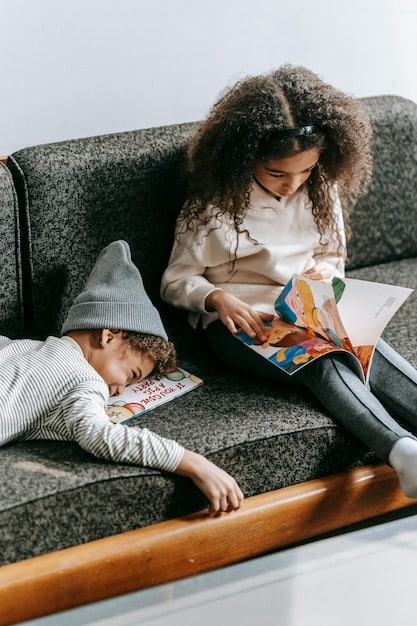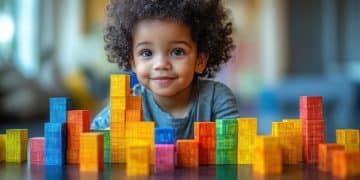Is Your Child Meeting Language Development Benchmarks? 2025 Guide

Navigating a child’s linguistic journey, this 2025 guide details essential language development benchmarks for children aged 2-5, offering parents practical insights to identify typical progress and potential areas for support.
For parents, witnessing a child’s growth is a journey filled with wonder and anticipation. One of the most fascinating aspects of this development is language acquisition. Understanding whether is your child meeting language development benchmarks? A 2025 guide for ages 2-5 offers clarity and reassurance, helping you recognize key milestones and foster robust communication skills from an early age.
Understanding the Foundations of Language Development
Language development is a complex and dynamic process, far more intricate than simply acquiring words. It encompasses listening, understanding, speaking, reading, and eventually writing. For children aged 2 to 5, this period is particularly critical, marking exponential growth in their ability to communicate effectively. This comprehensive guide, updated for 2025, aims to demystify these stages, providing parents with actionable insights into what to expect and how to foster a rich linguistic environment.
Every child’s journey is unique, influenced by genetics, environment, and individual temperament. However, a general timeline of developmental benchmarks exists, providing a crucial framework. These benchmarks are not rigid rules but rather guideposts, indicating patterns of typical development. Recognizing these patterns can help parents celebrate success and identify when professional guidance might be beneficial. Our focus here is on the practical application of these benchmarks, translating developmental theories into real-world observations.
The Role of Environment in Language Acquisition
A child’s immediate environment plays an undeniable role in shaping their language skills. From the moment they are born, children absorb information from their surroundings. This includes the frequency and quality of verbal interactions they experience. A language-rich environment, characterized by frequent conversations, reading aloud, and exposure to various vocabulary, significantly impacts a child’s linguistic trajectory. It’s about more than just hearing words; it’s about context, tone, and the dynamic exchange of ideas.
- Consistent Communication: Regular conversations, even about mundane activities, build strong foundations.
- Responsive Interactions: Acknowledging and responding to a child’s attempts at communication encourages further engagement.
- Exposure to Diverse Vocabulary: Introducing new words in context expands their understanding and expressive abilities.
- Reading Aloud: This is perhaps one of the most powerful tools, exposing children to narrative structures and a wide array of words.
Understanding these foundational elements allows parents to appreciate the holistic nature of language development. It’s not just about what a child says, but also how they interact with language and the spoken world around them. This section lays the groundwork for a more detailed examination of specific age-related benchmarks, ensuring parents have a clear perspective on the broader context of linguistic growth. The nuanced interplay between innate ability and environmental stimulation dictates the pace and depth of language acquisition.
Language Milestones for 2-Year-Olds: Emerging Voices
The transition from a toddler to a more articulate speaker is remarkably rapid around the age of two. This period is characterized by exciting leaps as children begin to string words together and express their needs and observations more clearly. Parents often notice a sudden ‘vocabulary explosion’ where new words are added to their child’s repertoire almost daily. It’s a phase of immense curiosity and burgeoning independence, mirrored in their communicative efforts.
At 24 months, a child typically starts to combine two words into simple phrases like “more juice” or “daddy car.” They can usually follow simple two-step instructions, such as “pick up the toy and put it in the box.” Their receptive vocabulary, the words they understand, far outpaces their expressive vocabulary, the words they can say. It’s crucial for parents to observe both aspects of their child’s language use. They might point to pictures in a book when asked, or correctly identify familiar objects and people.
Key Communicative Behaviors at Two
Beyond spoken words, communication at two involves a mix of gestures, babbling, and intonation. Children at this age use language to request, protest, comment, and get attention. Their interactions become more purposeful, and they start to engage in very basic back-and-forth exchanges. They are also learning the social rules of conversation, such as taking turns, though they may still struggle with maintaining a lengthy dialogue.
- Using 50+ words: A significant increase in their vocabulary.
- Forming 2-word phrases: Combining words to convey simple ideas.
- Following 2-step directions: Demonstrating improved comprehension.
- Naming familiar objects: Identifying common items like “ball” or “cup.”
- Understanding simple questions: Responding appropriately to “Where’s mommy?” or “What’s that?”
Parents can encourage this growth by engaging in descriptive talk, narrating daily activities, and asking open-ended questions. This provides a constant stream of language input and models appropriate sentence structures. While individual variations are normal, a consistent absence of these milestones might warrant a discussion with a pediatrician or a speech-language pathologist. The goal is to provide a supportive environment that facilitates natural language acquisition, ensuring the child feels heard and understood, which in turn boosts their confidence in using language.
Language Milestones for 3-Year-Olds: Building Sentences and Stories
As children reach their third birthday, their linguistic abilities undergo another significant transformation, moving beyond simple phrases to more complex sentences. This is the age where their expressive language truly blossoms, allowing them to participate in more sophisticated conversations and tell rudimentary stories. Their curiosity about the world around them manifests in an endless stream of “why” and “what” questions, reflecting their desire to understand and categorize information through language.
Three-year-olds typically speak in 3 to 4-word sentences, and their speech is generally intelligible to familiar adults most of the time. They can name most familiar objects, use plurals (e.g., “cats,” “toys”), and understand concepts like “in,” “on,” and “under.” Their storytelling might still be fragmented, but they are beginning to grasp the sequence of events and the role of characters. This increased linguistic competence also impacts their social interactions, allowing for more complex play and negotiations with peers.
Expanding Vocabulary and Grammar
At three, children are rapidly acquiring new vocabulary, often through exposure to books, conversations, and interaction with various stimulating environments. They begin to experiment with grammatical rules, sometimes over-regularizing verbs (e.g., “goed” instead of “went”) or plurals (e.g., “mouses” instead of “mice”). These “errors” are actually signs of healthy language development, indicating that they are actively applying and testing linguistic rules. It is a period of consolidation and expansion, where the building blocks of language start to form coherent structures.
- Speaking in 3-4 word sentences: Constructing more elaborate statements.
- Using plurals and past tense: Demonstrating emerging grammatical awareness.
- Answering “who,” “what,” “where” questions: Showing improved comprehension of specific details.
- Teller simple stories: Sequencing events, even if imperfectly.
- Understanding relational concepts: Grasping “big/small,” “open/close,” etc.

Support for language development at this age should focus on expanding their vocabulary and refining their sentence structure. Engaging in rich, descriptive conversations, reading a variety of books, and encouraging them to narrate their experiences are all beneficial. Parents can model correct grammar without overtly correcting every error, which can sometimes stifle a child’s communicative attempts. Instead, rephrasing their sentences using the correct form (“Yes, the cat went away, he left”) provides a gentle, effective correction. This encourages a natural learning process, reinforcing accurate language use without making the child feel apprehensive about making mistakes.
Language Milestones for 4-Year-Olds: Conversational Competence
By the age of four, most children have become competent communicators, capable of engaging in meaningful conversations and expressing a wide range of needs, feelings, and ideas. This stage is characterized by a notable increase in fluency and conversational stamina. Their sentences become longer and more grammatically complex, often incorporating conjunctions and more advanced sentence structures. They are also more adept at understanding and employing the social nuances of language, such as turn-taking and topic maintenance.
Four-year-olds typically speak in sentences of four or more words and can tell more detailed stories, often with a clear beginning, middle, and end. Their speech is largely intelligible, even to strangers, with only a few lingering articulation errors. They can follow more complex multi-step directions and answer abstract “why” and “how” questions, demonstrating a developing understanding of cause and effect. This increased linguistic sophistication enables richer imaginative play and more intricate social interactions with peers.
Refining Communication and Social Language
At four, children are not just learning words; they are learning how to use language strategically in social contexts. They understand how to ask for clarification, initiate conversations, and express empathy. Their play often involves elaborate role-playing scenarios, where language is used to define roles, negotiate plots, and direct action. This marks a significant cognitive leap, as language becomes a primary tool for both expressing their inner world and navigating their social landscape.
- Speaking in longer sentences (4+ words): Increased complexity and detail.
- Understanding concept words: Grasping “same/different,” “before/after.”
- Telling detailed stories: Including main ideas, characters, and events.
- Engaging in conversations: Practicing turn-taking and topic maintenance.
- Asking and answering “why” and “how” questions: Exploring reasoning and causality.
Parents can continue to foster these skills by encouraging storytelling, engaging in imaginative play, and reading books that introduce new concepts and vocabulary. Asking “what if” questions or hypothetical scenarios can also stimulate their language and critical thinking. Exposure to diverse linguistic environments, such as playgroups or preschool, further refines their social language skills. At this age, language becomes a powerful bridge between their inner thoughts and the external world, allowing for deeper self-expression and connection. Encouraging them to articulate their problems or feelings helps develop emotional intelligence alongside their linguistic abilities, preparing them for more complex social interactions.
Language Milestones for 5-Year-Olds: Preparing for School Success
As children approach the age of five, their language skills solidify, preparing them for the more structured linguistic environment of school. This period sees a significant refinement in both expressive and receptive language, making their communication increasingly precise and sophisticated. Five-year-olds are generally fluent and articulate, capable of engaging in extended conversations, expressing complex thoughts, and understanding nuanced instructions. They are transitioning from learning to speak to speaking to learn.
At five, children can typically speak in complete sentences with correct grammar most of the time. Their vocabulary is extensive, and they understand and use temporal concepts like “yesterday,” “today,” and “tomorrow.” They can retell a story accurately, discuss a picture with detail, and even engage in early literacy activities like recognizing some letters and sounds. Their ability to follow multi-step instructions without visual cues is well-established, indicating strong auditory processing and comprehension skills. This stage is often marked by an eagerness to learn and use new words, reflecting a growing awareness of language’s power.
Advancing Narrative and Early Literacy Skills
Beyond conversational fluency, five-year-olds begin to show signs of developing literacy. They can identify some letters of the alphabet, recognize their own name in print, and understand that print carries meaning. Their narrative skills become robust, enabling them to create detailed stories, often incorporating elements of fantasy and reality. This foundational literacy is crucial for future academic success, as it bridges spoken language with written communication.
- Speaking in complex, grammatically correct sentences: Mastering sentence structure.
- Understanding temporal concepts: Grasping time-related words (e.g., “morning,” “next week”).
- Retelling stories with main ideas and details: Demonstrating strong narrative comprehension.
- Recognizing some letters and sounds: Early phonological awareness.
- Answering questions about a story just heard: Indicating attentive listening and recall.

To support a five-year-old’s language development, continue to engage in rich conversations, read together daily, and encourage them to express their thoughts and feelings. Playing word games, practicing rhyming, and discussing the meanings of new words can further enhance their vocabulary and phonological awareness. Encouraging them to “read” familiar books by retelling the story based on pictures is also highly beneficial. These activities not only strengthen their language foundation but also instill a love for reading and learning. The transition into formal schooling becomes smoother when these strong linguistic skills are in place, equipping them with the tools they need to succeed academically and socially in a classroom setting.
Identifying Potential Concerns and When to Seek Help
While the benchmarks outlined provide a general framework for language development, it’s equally important for parents to recognize when their child’s progress might deviate significantly from these patterns. Early identification of potential concerns is crucial, as timely intervention can profoundly impact a child’s long-term communicative abilities. It’s not about comparing your child rigidly to others, but understanding if their development is within a typical range or if they might benefit from additional support.
Some key indicators that might suggest a need for further evaluation include a significant delay in speaking, difficulty understanding simple instructions, or a noticeable regression in previously acquired language skills. A child who relies heavily on gestures instead of words, shows minimal attempts to communicate, or has persistent difficulty being understood by familiar adults despite their age might warrant attention. Trust your parental instincts; if something feels “off” about your child’s language development, it’s always best to investigate.
Common Red Flags and Next Steps
There are several specific “red flags” that, if observed consistently, should prompt a conversation with a healthcare professional. These are not definitive diagnoses but rather signals that a more thorough assessment may be necessary. It’s better to be proactive and seek advice early than to delay, as early intervention often yields the best outcomes. Pediatricians are an excellent first point of contact, as they can provide initial guidance and refer to specialists if needed.
- Lack of expressive vocabulary: Fewer words than expected for their age.
- Difficulty understanding simple directions: Persistent struggles even with clear instructions.
- Limited use of gestures or pointing to communicate: A general lack of intentional communication attempts.
- Repetitive or echoed speech: Speech that primarily repeats what others say.
- Poor eye contact during communication: An indication of potential social-communication challenges.
When you have concerns, the first step is typically to discuss them with your child’s pediatrician. They can conduct an initial screening and, if necessary, refer you to a speech-language pathologist, audiologist, or developmental pediatrician. A speech-language pathologist can conduct comprehensive assessments to identify specific areas of difficulty and recommend appropriate therapeutic interventions. Remember, seeking help is a sign of proactive parenting and commitment to your child’s well-being. Early intervention can unlock a child’s full communication potential, providing them with the tools they need to thrive. It’s about providing the right support at the right time, fostering an environment where every child has the opportunity to develop strong linguistic foundations.
Fostering a Language-Rich Environment in 2025
In 2025, with increasing digital distractions and varied family dynamics, creating a genuinely language-rich environment for children aged 2-5 is more vital than ever. It’s not just about minimizing screen time, but intentionally maximizing quality, interactive communication. The goal is to make language acquisition a natural, enjoyable, and consistent part of daily life, extending beyond formal learning settings into every interaction. This involves conscious effort from parents and caregivers to prioritize verbal engagement.
Leveraging the best of modern resources while maintaining traditional, high-quality interaction is key. This means thoughtfully integrating educational apps and programs that support language, rather than replace human interaction. It also involves being present and engaged when speaking with children, making eye contact, and responding meaningfully to their attempts at communication. The essence of a language-rich environment remains consistent: ample opportunities for children to hear language, practice it, and be understood.
Practical Strategies for Parents
There are numerous practical strategies parents can employ to ensure their home is a vibrant hub for language development. These strategies are often simple, requiring consistency and intentionality rather than significant financial investment. They focus on embedding language learning into daily routines, making it seamless and organic. From meal times to errands, every moment presents an opportunity for linguistic enrichment and growth.
- Narrate your actions: Describe what you’re doing, seeing, and feeling. “I’m cutting the apple for your snack.”
- Ask open-ended questions: Encourage more than a “yes” or “no” answer. “Tell me about your favorite part of the park.”
- Read aloud daily: Make reading a cherished routine, varying books and discussing content.
- Sing songs and recite rhymes: Develop phonological awareness and rhythm.
- Engage in imaginative play: Use different voices and scenarios to expand vocabulary and narrative skills.
Beyond these activities, reducing background noise from televisions or other devices can significantly improve a child’s ability to focus on and process spoken language. Creating specific times for “talk turns” where the child leads the conversation can also be beneficial. Remember, it’s the quality of interaction, not just the quantity, that makes the difference. By consciously weaving language into the fabric of daily life, parents equip their children with a powerful tool for learning, connecting, and thriving in an ever-evolving world. This intentional approach ensures that as children grow, their linguistic abilities develop robustly, empowering them to express themselves fully and understand the world around them with increasing clarity and depth.
| Key Milestone | Brief Description |
|---|---|
| 🗣️ 2-Year-Olds: Word Bursts | Combine 2-word phrases; follow 2-step directions. |
| 📚 3-Year-Olds: Sentence Structures | Speak in 3-4 word sentences; use plurals and simple tenses. |
| 💬 4-Year-Olds: Conversational Fluency | Longer sentences; tell detailed stories; ask “why/how.” |
| 🎓 5-Year-Olds: School Readiness | Complex sentences; understand temporal concepts; early literacy. |
Frequently Asked Questions About Language Development
A child aged 2 typically develops a vocabulary of at least 50 words and starts combining two words. If a 2-year-old has fewer than 50 words or isn’t consistently using two-word phrases, it could indicate a language delay. Other signs might include difficulty following simple instructions or not responding to their name, which warrant further assessment.
Reading aloud is profoundly important. It introduces children to a wider vocabulary, complex sentence structures, and narrative concepts they might not encounter in daily conversation. It also builds phonological awareness, listening skills, and stimulates imagination, all crucial for both language development and future literacy success. Consistency is key for maximum benefit.
Yes, excessive screen time, especially passive viewing, can negatively impact language development. Children learn language best through interactive communication with real people. Screens offer minimal back-and-forth interaction and do not provide the contextual cues vital for understanding nuances of language. Limiting screen time and prioritizing active engagement is recommended.
Consult a professional if you notice significant delays or regressions in language milestones for your child’s age. This includes a lack of words, difficulty being understood, no progress in combining words, or a general lack of communicative intent. Your pediatrician is a great first point of contact, often recommending a speech-language pathologist for assessment.
For 4-year-olds, encourage language by engaging in rich conversations, asking open-ended questions that prompt detailed answers, and promoting storytelling. Introduce new vocabulary through books and discussions. Play games that involve rhyming or identifying sounds. Most importantly, respond enthusiastically to their communication attempts to boost confidence and motivation.
Conclusion
Navigating the rich landscape of language development for children aged 2-5 can be one of the most rewarding aspects of parenting. By understanding the key milestones and fostering a nurturing, language-rich environment, parents can provide their children with the best foundation for effective communication and lifelong learning. While every child progresses at their own pace, being aware of general benchmarks empowers parents to celebrate achievements and, crucially, to recognize when professional support might offer an invaluable boost. The insights from this 2025 guide are designed to equip you with the knowledge and confidence to support your child’s journey towards becoming a confident and articulate communicator.





